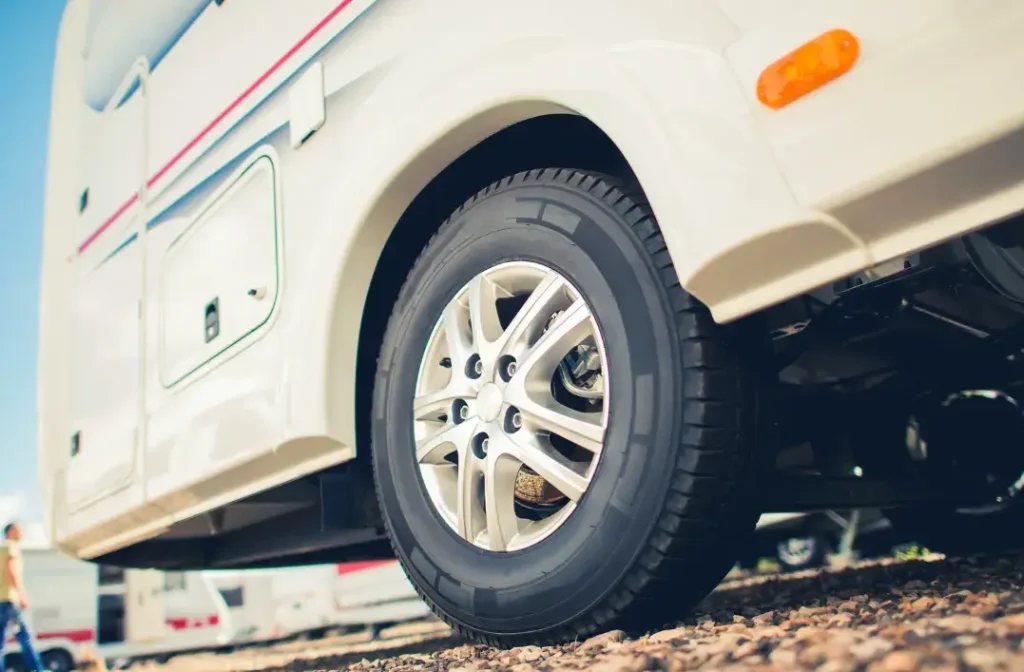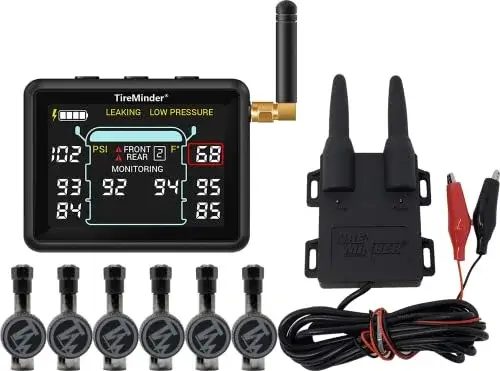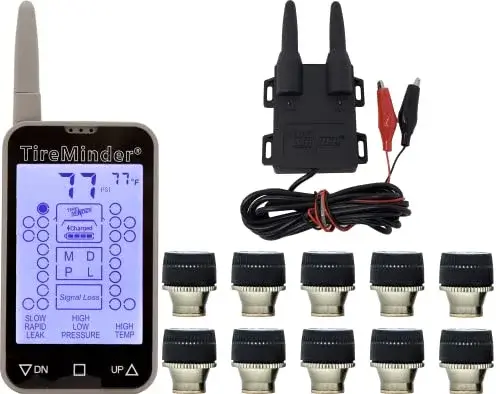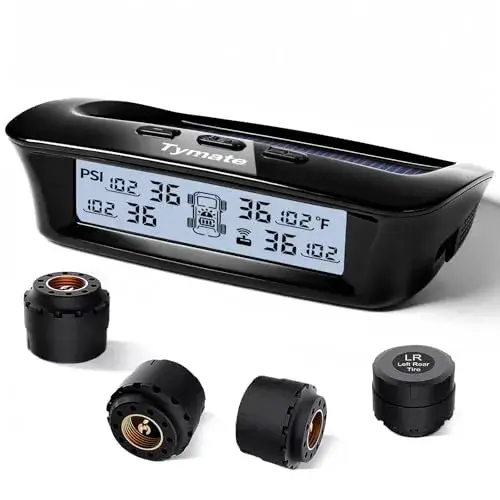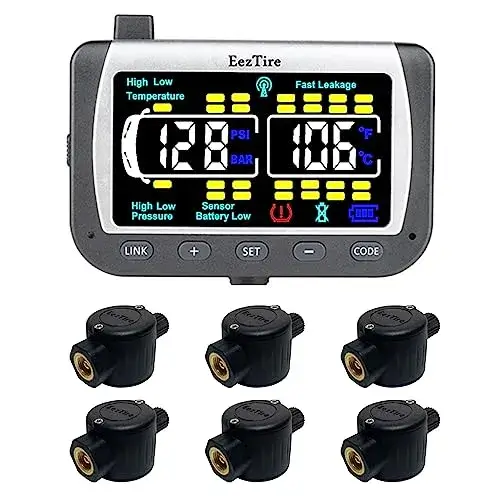RVers, today we’re talking about tire safety. Specifically, we’re talking about Tire Pressure Monitoring Systems, or TPMS for short.
Even more specifically, we’re talking about the BEST RV TPMS for your adventures ahead.
This is crucial for a safe road. Motorhomes are complex creatures and poor tire health, or worse yet a blow out on the road, can teeter that balance and your budget into unsafe territory.
Luckily, we have the best TPMS on the market right here! The i10 RV TPMS from TireMinder is my top pick for a comprehensive and value-stacked system that fits most rigs seamlessly. With performance out the wazoo and at very competitive pricing, you can’t go wrong with this purchase!
But just don’t take my word and years of RVing experience at face value. Dive into this article and see why you need a tire pressure monitoring system for your rig and what one to get. I have multiple recommendations!
…All those averted crises on the road gave me an eagle eye for top-value solutions. 😉
So let my mistakes be your saving grace. DON’T leave home with unprotected and unsafe tires.
Get the lowdown on the best RV TPMS right here! It pays dividends to invest in peace of mind.
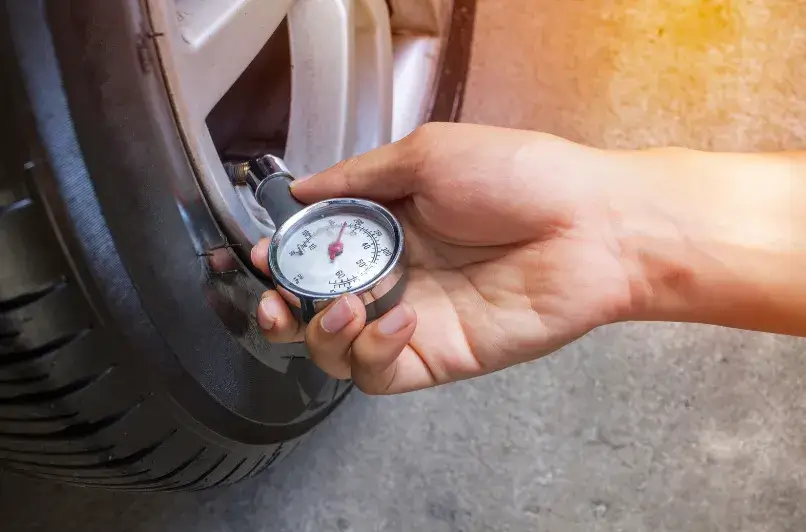
The Best RV TPMS: Our Top 4 Picks
- TireMinder RV TPMS [Best Overall]
- TireMinder A1A-10 RV TPMS [Best Splurge]
- Tymate RV TPMS – M12-3 [Best Budget]
- EEZ RV Products EEZTire-TPMS 6ATC [Best for Easy Installation]
Do RVs Come Equipped with a Tire Pressure Monitoring System (TPMS)?
No. Most RVs do NOT come equipped with a Tire Pressure Monitoring System (TPMS) straight from the manufacturer.
While it’s standard in many modern passenger vehicles, many motorhomes skip out on this essential piece of RVing gear. Older models, in particular, definitely won’t come TPMS-equipped, and a lot of contemporary rigs won’t either.
This can catch a lot of new RVers off-guard. You’re spending tens, maybe hundreds, of thousands of dollars on a state-of-the-art motorhome. Yet no TPMS…
That’s why I ALWAYS recommend investing in a high-quality aftermarket TPMS! It’s a higher upfront cost on a system that can save you oodles more from costly tire blowouts and troubles later down the line. It’s annoying, but it’s better to be mildly annoyed by the realities of late-stage capitalism now than the realities of road-life later.
Invest in a TPMS.
Is a TPMS Necessary for an RV?
Yasss! Absolutely. Safety is non-negotiable.
A TPMS is key to safer driving in an RV. RVs are heavy. Not all roads are good roads. Some backroads may as well not be roads at all.
It’s your big, beautiful RV tires that take the brunt of this chaos. A tire blowout on a rig can lead to, at best, a tire change repair. Mid-case scenario, you’re left stranded in the middle of nowhere. Worst case scenario, a high-speed blowout rolls your whole RV like the world’s most mangled burrito!
I apologize for the grisly image, but that’s the reality. I’ve personally seen many RVers suffer from perfectly avoidable blowouts all because they weren’t monitoring their tire pressure.
That’s where a TPMS comes in! A good monitoring system for your RV’s tires alerts you BEFORE things go wrong. Hear the beep, pull over, and crisis averted.
A lot of road-warriors stumble around unarmored. Some are perfectly fine, but some suffer the consequences.
A true road-warrior knows to protect themself. And to respect their arms. Don’t start heading out into the boonies unprotected!
A TPMS has your back.
The 4 Best RV TPMS Reviewed
Convinced yet? Of course you are! You’re a safe and smart nomad. 🙂
Let there be no more beating around the bush. Get yourself the BEST RV TPMS and protect your rig from tire troubles.
Best Overall
1. TireMinder RV TPMS
- Pressure Monitoring Range: 0-199 PSI
- Included Sensors: 6
- Battery Life: 8-12 hours/charge
TireMinder’s i10 RV TPMS is my top pick of systems to keep you rolling smooth. This is all down to the value the unit offers. Tire monitoring systems are expensive, but the i10 manages to deliver an excellent balance of ease, accuracy, and reliability all at a still reasonable price range.
TireMinder’s tech is solid work. The six onboard sensors, in particular, harness flow-through design to maximize the system’s usability. This design allows you to add inflate and deflate the tires without removing the sensors, which is a HUGE win for eliminating thankless busy work.
Keeping the tasty tech coming, the TPMS also comes with an integrated real-time alert system equipped with a signal booster. Any sudden changes in tire or temperature, and you can save yourself from a blowout quick-smart thanks to the alerts. All without dropped connections.
The downside here is the battery life. It’s small. And unforgiving. It’ll last you one full day of driving, but forget to recharge them and the TPMS is unlikely to make it through day two. Make sure you have a good battery in your RV and accompanying electrical system to maintain your charge!
On the plus side, you can charge it right from your cigarette port! Yeah, that’s another device’s juice status to manage, but the reward is one of the downright BEST value TPMS for RVs. Embark with peace of mind!
Best Splurge
2. TireMinder A1A-10 RV TPMS
- Pressure Monitoring Range: 0-232 PSI
- Included Sensors: 10
- Battery Life: 2-4 weeks
Or just screw value. Less is more? More is more. With more sensors, more range, and MUCH more battery life, TireMinder’s A1A-10 model more than earns its premium position on this list.
Truthfully, at only six sensors out of the box, the i10 isn’t for all RVers. Sometimes, as all Class A RVers and owners of luxurious fifth-wheel setups know, you do need more. Built for bigger rigs with its 10 included sensors, the A1A-10 is the choice for more complex motorhomes.
Moreover, the increased range (up to 232 PSI) is another good fit for bigger RVs and especially towables. Top that off with the same primo features, alert system, and signal booster of the i10, and you have Tireminder’s bigger and better unit for those who need the extra muscle.
Now, while the battery life is vastly improved, it is a sad note that these aren’t flow-through sensors. That means more busy work come maintenance time. And, of course, the price of the A1A-10 is pushing into the high-end range too.
But if you’re serious about protecting your tires, then it’s worth every dime! ESPECIALLY if you do have a bigger rig. Tire blowouts on luxury motorhomes are costly. So protect your baby with a feature-packed and performance-stacked system.
Best Budget
3. Tymate RV TPMS – M12-3
- Pressure Monitoring Range: 0-87 PSI
- Included Sensors: 4
- Battery Life: Up to 2 years
Sometimes innovation and frugality come in the same package! If the TireMinder systems were just too much for way too much, here is a much simpler solution for less than a third of the price!
Now, in this case, less is more. With fewer sensors and a lower monitoring range, the Tymate won’t suit all classes and categories of RVs. (However, a six-sensor model is available instead.)
However, what the Tymate lacks in sheer power it makes up for in technique. Firstly, check out that one-year-plus battery life… This is all thanks to the TPMS’s auto-solar charging functionality. This innovative feature keeps the batteries juiced up on the road and eliminates your charging woes until it’s time to replace them.
Otherwise, the Tymate, despite its cheaper price point, still hits a lot of other solid marks. There’s backup AC/DC charging, a five-alarm system, and numerous other quality-of-life features all integrated into the unit.
The TPMS is admittedly somewhat hampered by its budget status. Moreover, the reduced monitoring range and total sensor count definitely mean that the Tymate is better suited to smaller RVs overall.
But if you have a smaller RV and were hoping to spend a few hundred dollars less than with something from TireMinders, Tymate is 100% the way to go. It’s the stripped-back budget TPMS solution with some frills still attached!
Best for Easy Installation
4. EEZ RV Products EEZTire-TPMS 6ATC
- Pressure Monitoring Range: 0-210 PSI
- Included Sensors: 6
- Battery Life: Up to 60 hours
Let’s circle back to flow-through sensors and easy use with the EEZTire-TPMS. Promising quick setup and foolproof operations, the EEZTire gets its name for a reason!
First up, those six sensors. They ARE indeed flow-through sensors and, furthermore, come pre-programmed as well! Thanks to this, you can skip the tedious pairing process. The only thing you need to do is screw the sensors onto your valve stems and you’re on your way!
But good hardware calls for good software too. The EEZTire pairs its stress-free sensors with a user-friendly monitoring system and large LCD display. The large screen displays real-time data clearly and intuitively, completing the device’s simple setup with equally simple operations. It’s a fantastic gadget for RVing—even for those who aren’t tech-savvy!
Now, the device does not include a signal booster, unlike the two TireMinder units. Unfortunately, this does show with users reporting infrequent but nonetheless still-occurring signal drops.
It’s a shame because otherwise, the EEZTire is a fantastic TPMS that delivers on the name. It’s a borderline plug-and-play solution and very much a consideration for anybody who prioritizes straight-shooting usability. You just might have to weather the odd signal loss!
FAQs About TPMS and Maintaining Proper Tire Pressure in an RV
Much like painting your RV’s exterior and other bits of motorhome maintenance, installing a TPMS is not a set-and-forget solution. Sometimes, we need to get our hands stuck into some troubleshooting!
Look after your tire pressure monitoring system and it will look after you! Here are some last crucial consideration before you commit to a purchase.
How Do I Reset an RV TPMS?
Resetting your RV’s TPMS depends on the specific system and model you have. That said, the process is usually pretty straightforward.
Most TPMS units require you to access the monitor’s settings in order to reset them. Somewhere in there, there are typically options to “reset” or “relearn” sensors.
Once in reset mode, you’ll need to deflate and then reinflate each tire in order for the system to register the correct pressures. For wireless models, resetting can be as simple as holding down the main button for a few seconds.
If in doubt, refer to your TPMS’s manual for the exact steps! It never hurts to keep a hard copy of them in your glove box either.
Will a TPMS work for trailer Tires?
Yes, most definitely. Not only will a TPMS work with a towable RV like a travel trailer or fifth wheel, but it’s actually highly recommended. Most TPMS systems, like the EEZTire or TireMinder, come with additional sensors that you can install on trailer tires alongside your vehicle. This way, you’re covered from front to back!
Trailers are just as vulnerable to tire issues. Having a robust TPMS is a key recommendation for anybody lugging a load. Without a TPMS, you might not even notice a problem until it’s too late, and then it’s game over for the road trip.
How Do I Know if My RV’s TPMS is Working or Not?
First things first, a healthy and functioning TPMS will give you real-time tire pressure and temperature readings on the monitor. If those numbers aren’t showing up, changing, or they just seem off, that’s your first red flag.
As an initial test, I would recommend taking your RV for a short drive while keeping an eye on the monitor. If the sensors are working, you’ll see those readings update as you drive and the tires warm up.
If you’re not seeing any data or the readings seem inaccurate, double-check that all sensors are properly installed on the valve stems. Sometimes, a sensor can loosen or the battery might be dead, which means recharging or replacing it. (You might even want to try resetting and recalibrating the system.)
Oh and one more troubleshooting tip for TPMS systems? Manually deflate a tire by a little as a test. If your TPMS alerts you immediately, you’re good to go.
Lastly, always make sure your monitor and sensors are charged and properly synced. A little maintenance goes a long way in ensuring your TPMS is working right!
Our Verdict: What’s the Best TPMS System for RV Owners?
Leverage those dividends! Invest in peace of mind. Buy an RV TPMS.
One more time, the top value contender is clear. For most rigs, small and big, the TireMinder i10 RV TPMS covers the essential bases. It’s an all-around value-meets-performance unit that you really can’t go wrong with.
Alternatively, for big complex rigs (like Class As and fifth wheels), go for the TireMinder A1A-10 RV TPMS. It’s big, it’s beefy, and with support for up to 22 tires, there’s very few rigs on the planet it’s not equipped to protect.
Just make sure that you DO get a TPMS. They work. They save money. Hell, they save lives.
An investment now and an extra system to monitor can seem like a lot of hassle. But I guarantee that it’s a lot less hassle than losing a tire halfway across the Nevadan desert!
Frugal road-warriors know how to save cash. But smart road-warriors know when it’s time to spend cash.
Be a smart road-warrior. Protect your rig, your passengers, and yourself.
Long drives are for relaxing.
